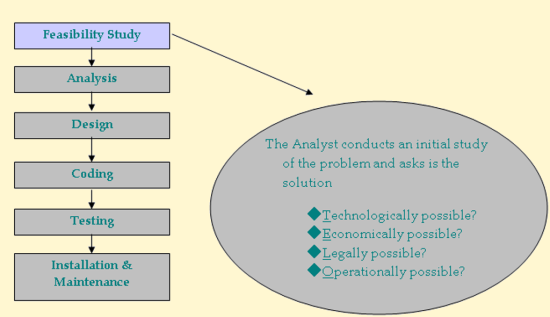
By Ivana Zuber
What Is a Feasibility Study?
A feasibility study is a brief study that checks whether the system contributes to organizational goals, whether it can be designed using current technology and within the planned budget and whether it can be integrated with other used systems. The goal of the feasibility study is to evaluate whether the proposed system is worth the time and effort to develop (BBC, n.d). It is important to conduct a feasibility study before making a decision about investing in a large system that is not indispensable, or does not resolve key problems in business processes.
Which areas should the Feasibility Study address?
There are three main areas that every effective feasibility study should address. Firstly, a feasibility study should evaluate the operational feasibility (the level of product usability). Secondly, a feasibility study should compare the technology available for development and the technology required for the product to function properly. And finally, a feasibility study should study the cost and the effort of software development and compare them to the overall benefits and profits.
Cost and Effort Estimation
 Estimation of software cost is an important part of the feasibility study that investigates economic profitability and helps project managers to build up project plans and schedules. In order to predict the software cost, it is important to evaluate the effort needed to develop the system (CodeProject). The estimation of effort and its monitoring during the development of the software product is an integral part of project planning. The size of the effort is primarily determined by features of the system being developed, such as the size and the complexity of the system, the selected technology and the methodology applied during development. On the other hand, effort and cost estimation depend on the dynamics of available human resources responsible for the realization of the planned work (they depend on their expertise and availability).
Estimation of software cost is an important part of the feasibility study that investigates economic profitability and helps project managers to build up project plans and schedules. In order to predict the software cost, it is important to evaluate the effort needed to develop the system (CodeProject). The estimation of effort and its monitoring during the development of the software product is an integral part of project planning. The size of the effort is primarily determined by features of the system being developed, such as the size and the complexity of the system, the selected technology and the methodology applied during development. On the other hand, effort and cost estimation depend on the dynamics of available human resources responsible for the realization of the planned work (they depend on their expertise and availability).
An effective feasibility study must take all named factors into account, but also has to evaluate other important elements affecting the development process. Some of those “secondary” elements include:
- New gained experience (developers gain new experience in the application development as well as experience in working with the platform)
- Implementation of product features. (Product features can have a major impact on effort and cost. They include the size, the required amount of reuse, the required reliability, complexity, the limitations of space and time deposit restrictions, and stability of the infrastructure on which the program relies).
- Environmental factors (such as technology (possible reuse of parts), methods and tools of software engineering that can be applied, personal incentives and career goals, and working conditions (such as development in multiple locations or tight schedule development).
 The need for a reliable cost and effort assessment depends on its purpose in a given time. Cost estimation at the beginning of the project, during the feasibility study, doesn’t have to be completely accurate. Its purpose is only to help with making decisions about the detailed definition of the project. Evaluation in the requirement specification phase, on the other hand, has to be made with reasonable accuracy. It is at this point that the decision to invest significant resources is made, based upon the specification report. Bad business decisions are often a result of poor software requirement specifications.
The need for a reliable cost and effort assessment depends on its purpose in a given time. Cost estimation at the beginning of the project, during the feasibility study, doesn’t have to be completely accurate. Its purpose is only to help with making decisions about the detailed definition of the project. Evaluation in the requirement specification phase, on the other hand, has to be made with reasonable accuracy. It is at this point that the decision to invest significant resources is made, based upon the specification report. Bad business decisions are often a result of poor software requirement specifications.
Atkins, D., Mockus, A., & Siy, H, (2000), ‘Measuring Technology Effects on Software Change Cost’, Bell Labs Technical Journal, 5, 2, pp. 7-18, Business Source Premier
Issa, A, & Rub, F (2007), ‘Performing Early Feasibility Studies of Software Development Projects Using Business Process Models’, World Congress On Engineering 2007 (Volume 1), pp. 536-540, Academic Search Complete
Laird, L, & Brennan, M (2006), Software Measurement And Estimation [Electronic Book] : A Practical Approach / Linda M. Laird, M. Carol Brennan, n.p.: Hoboken, N.J. : Wiley-Interscience, 2006.
Pendharkar, P, & Rodger, J (n.d.), ‘An empirical study of the impact of team size on software development effort’, Information Technology & Management, 8, 4, pp. 253-262, Social Sciences Citation Index
This article was written by Ivana Zuber – Software Developer, writer, and owner of
BloggLess(site no longer exists). As a constant learner and an MSc in Software Engineering student, Ivana is always aiming towards new ideas and greater knowledge. When she is not coding, reading, or writing for blogs, you can find her jogging outside, or ‘hanging around’ social media sites.

